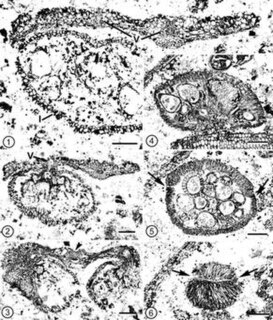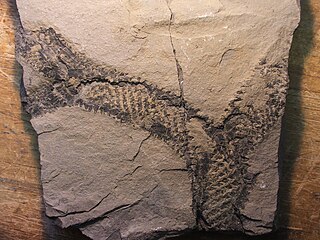
The Pinophyta, also known as Coniferophyta or Coniferae, or commonly as conifers, are a division of vascular land plants containing a single extant class, Pinopsida. They are cone-bearing seed plants, a subset of gymnosperms. All extant conifers are perennial woody plants with secondary growth. The great majority are trees, though a few are shrubs. Examples include cedars, Douglas firs, cypresses, firs, junipers, kauri, larches, pines, hemlocks, redwoods, spruces, and yews. As of 1998, the division Pinophyta was estimated to contain eight families, 68 genera, and 629 living species.

The gymnosperms, also known as Acrogymnospermae, are a group of seed-producing plants that includes conifers, cycads, Ginkgo, and gnetophytes. The term "gymnosperm" comes from the composite word in Greek: γυμνόσπερμος, literally meaning "naked seeds". The name is based on the unenclosed condition of their seeds. The non-encased condition of their seeds contrasts with the seeds and ovules of flowering plants (angiosperms), which are enclosed within an ovary. Gymnosperm seeds develop either on the surface of scales or leaves, which are often modified to form cones, or solitary as in yew, Torreya, Ginkgo.

Metasequoia, or dawn redwoods, is a genus of fast-growing deciduous trees, one of three species of conifers known as redwoods. The living species Metasequoia glyptostroboides is native to Lichuan county in Hubei province, China. Although the shortest of the redwoods, it grows to at least 165 feet in height. Local villagers refer to the original tree from which most others derive as Shui-shan (水杉), or "water fir", which is part of a local shrine. Since its rediscovery in 1944, the dawn redwood has become a popular ornamental, with examples found in various parks in a variety of countries.

Metasequoia glyptostroboides, the dawn redwood, is a fast-growing, endangered deciduous conifer. It is the sole living species of the genus Metasequoia, one of three genera in the subfamily Sequoioideae of the family Cupressaceae. It now survives only in wet lower slopes and montane river and stream valleys in the border region of Hubei and Hunan provinces and Chongqing municipality in south-central China, notably in Lichuan county in Hubei. Although the shortest of the redwoods, it can grow to 120 ft (37 m) in height.

Cyathea cranhamii is an extinct species of tree fern. It was described based on permineralised sori from the Early Cretaceous deposits of Apple Bay in Vancouver Island, British Columbia.

Lepidodendrales were primitive, vascular, arborescent (tree-like) plants related to the lycopsids. Members of Lepidodendrales are the best understood of the fossil lycopsids due to the vast diversity of Lepidodendrales specimens and the diversity in which they were preserved; the extensive distribution of Lepidodendrales specimens as well as their well-preservedness lends paleobotanists exceptionally detailed knowledge of the coal-swamp giants’ reproductive biology, vegetative development, and role in their paleoecosystem. The defining characteristics of the Lepidodendrales are their secondary xylem, extensive periderm development, three-zoned cortex, rootlike appendages known as stigmarian rootlets arranged in a spiralling pattern, and megasporangium each containing a single functional megaspore that germinates inside the sporangium. Many of these different plant organs have been assigned both generic and specific names as relatively few have been found organically attached to each other. Some specimens have been discovered which indicate heights of 40 and even 50 meters and diameters of over 2 meters at the base. The massive trunks of some species branched profusely, producing large crowns of leafy twigs; though some leaves were up to 1 meter long, most were much shorter, and when leaves dropped from branches their conspicuous leaf bases remained on the surface of branches. Strobili could be found at the tips of distal branches or in an area at the top of the main trunk. The underground organs of Lepidodendrales typically consisted of dichotomizing axes bearing helically arranged, lateral appendages serving an equivalent function to roots. Sometimes called "giant club mosses", they are in fact more closely related to quillworts than to club mosses.

The Paskapoo Formation is a stratigraphic unit of Middle to Late Paleocene age in the Western Canada Sedimentary Basin. The Paskapoo underlies much of southwestern Alberta, and takes the name from the Blindman River. It was first described from outcrops along that river, near its confluence with the Red Deer River north of the city of Red Deer, by J.B. Tyrrell in 1887. It is important for its freshwater aquifers, its coal resources, and its fossil record, as well as having been the source of sandstone for the construction of fire-resistant buildings in Calgary during the early 1900s.

Sequoioideae, popularly known as redwoods, is a subfamily of coniferous trees within the family Cupressaceae. It includes the largest and tallest trees in the world.

Abies milleri, an extinct species of fir known from fossil remains found in deposits from the early Eocene Ypresian stage in Washington State, USA, is the oldest confirmed record for the fir genus. The species was described from 81 fossil specimens collected from Burke Museum site number A0307 in Ferry County, Washington. The holotype specimen, number # UWBM 31299, and the eleven paratype specimens are currently deposited in the collections of the Burke Museum in Seattle, where they were studied and described by Howard E. Schorn and Wesley C. Wehr. Schorn and Wehr published their 1986 type description for A. milleri in the Burke Museum Contributions in Anthropology and Natural History, Volume 1. The specific epithet, milleri, was coined in honor of Charles N. Miller Jr for his contributions to the study and understanding of the conifer family Pinaceae. The studied specimens were excavated from the Tom Thumb Tuff member of the Klondike Mountain Formation in the city of Republic.
Pinus matthewsii is an extinct species of conifer in the pine family. The species is solely known from the Pliocene sediments exposed at Ch’ijee's Bluff on the Porcupine River near Old Crow, Yukon, Canada.

Araucaria mirabilis is an extinct species of coniferous tree from Patagonia, Argentina. It belongs to the genus Araucaria.

Ginkgo cranei is an extinct Ginkgo species in the family Ginkgoaceae described from a series of isolated fossil ovulate organs and leaves. The species is known from upper Paleocene sediments exposed in the state of North Dakota, USA. It is the first Ginkgo species to be described from Paleogene period with reproductive structures.
The Princeton Chert is a fossil locality in British Columbia, Canada, which comprises an anatomically preserved flora of Eocene Epoch age, with rich species abundance and diversity. It is located in exposures of the Allenby Formation on the east bank of the Similkameen River, 8.5 km (5.3 mi) south of the town of Princeton, British Columbia.
Pinus driftwoodensis is an extinct species of conifer in the pine family solely known from early Eocene sediments exposed in south central British Columbia. The species was described from an isolated fossil ovulate cone associated with a series of wood, needles and pollen cones in chert. P. driftwoodensis was the eighth pine species to be described from a permineralized ovulate cone and the second from the Okanagan highlands.

Metasequoia occidentalis is an extinct redwood species of the family Cupressaceae that is found as fossils throughout the Northern Hemisphere. It is one of three extinct species of Metasequoia that are currently recognized as valid.

Glyptostrobus europaeus is an extinct conifer species of the family Cupressaceae that is found as fossils throughout the Northern Hemisphere. The sole living species of Glyptostrobus was described from China in 1926. The name of the genus comes from the Greek "glypto" meaning grooved or carved, and "strobilus" meaning cone. The species name "europaeus" refers to the fact that it was first described from Europe.
Pinus yorkshirensis is an extinct species of pine tree. The fossil pine cone came from Hauterivian and Barremian-aged sedimentary rocks located in the Speeton Clay in Yorkshire.

Metasequoia heerii is an extinct redwood species of the family Cupressaceae that is found as fossils throughout the Northern Hemisphere. It is one of several proposed extinct species of Metasequoia that were previously referred to Sequoia.
Hughmillerites is a fossil cypress, found in the Late Jurassic of Scotland and Early Cretaceous of Canada.












